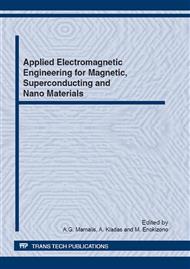p.147
p.153
p.159
p.165
p.171
p.179
p.185
p.191
p.199
Experimental and Theoretical Analysis of Iron Losses of Electrical Steels Subjected to Distorted Supply Voltage Waveform Conditions
Abstract:
Iron losses of grain-oriented electrical steels, is sensitive to the distortion of the supply voltage waveform of the excitation winding. As a result, magnetic cores of electrical machines and transformers manufactured of grain-oriented electrical steels present significant increase of iron losses when working under distorted supply voltage waveform. In the present paper, an experimental apparatus is developed in order to evaluate the effect of distorted supply voltage waveform on iron losses of grain-oriented electrical steels. Also, a theoretical analysis based on the hysteresis design tool of Matlab and the finite element method considering hysteresis is carried out.
Info:
Periodical:
Pages:
171-176
Citation:
Online since:
June 2012
Price:
Сopyright:
© 2012 Trans Tech Publications Ltd. All Rights Reserved
Share:
Citation:


